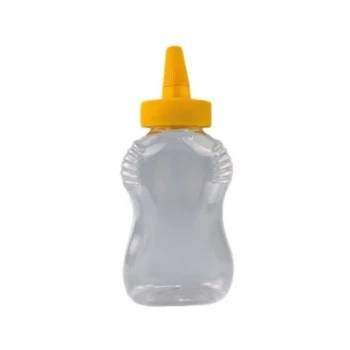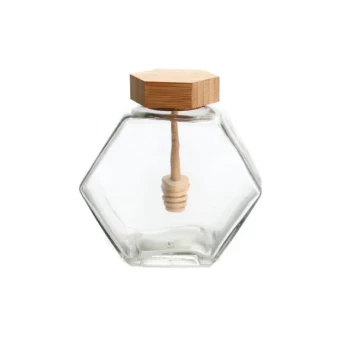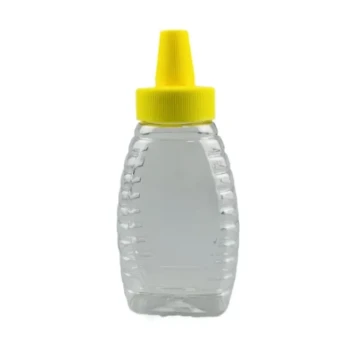To transport queen cells correctly, you must treat them with extreme care, focusing on three critical factors: maintaining their vertical orientation, protecting them from any physical shock or vibration, and keeping them within a stable, warm temperature range. These cells contain live, developing queens in their most fragile pupal stage, and failure in any of these areas can easily lead to their death.
A queen cell is not a durable product; it is a delicate life support system for a developing queen. Successful transport depends entirely on your ability to replicate the stable, shock-free, and temperature-controlled environment of the brood nest until the cells are placed in their new colonies.
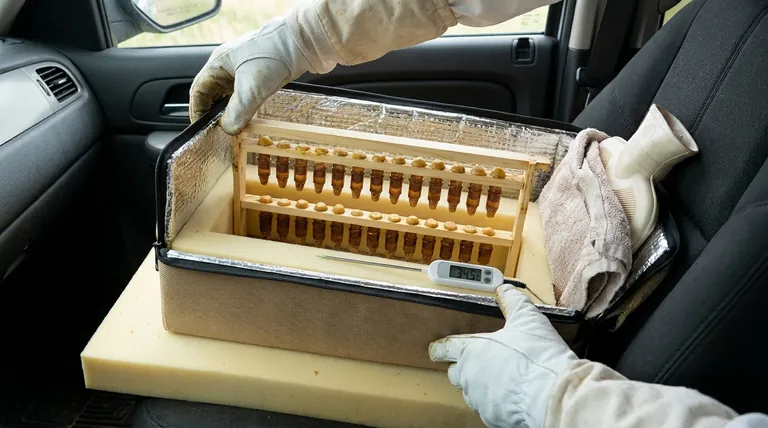
The Core Principles of Queen Cell Transport
Understanding why these handling rules exist is the key to preventing loss. The developing queen inside the cell is in a vulnerable pupal state, where she is sensitive to any environmental instability.
Maintaining Proper Orientation
A queen cell is designed to hang vertically from the comb. The developing queen pupa inside is positioned in a specific way, suspended head-down.
Tilting or inverting the cell, especially for extended periods, can dislodge the pupa or disrupt its delicate internal development, which is often fatal. Always keep the cells pointing downwards, just as they would be in the hive.
Avoiding Physical Shock
The pupa is attached to the inside of the cell by very fine, fragile connections. Any sudden jolt, vibration, or shaking can sever these connections.
When this happens, the pupa detaches and falls to the bottom of the cell, which causes irreversible damage and death. This is why you must never shake a frame with queen cells and must provide a smooth, cushioned ride during transport.
Regulating Temperature
The brood nest of a honey bee colony is maintained at a remarkably stable temperature, typically around 93-95°F (34-35°C). The developing queen is adapted to this specific environment and has very little tolerance for deviation.
Overheating is a significant risk. Leaving cells in a car or in direct sunlight can quickly raise their temperature to lethal levels, essentially "cooking" the pupa inside.
Chilling is equally dangerous. Exposure to cold air, wind, or a cool environment can halt the queen's development or kill her outright. The longer the exposure, the greater the risk of damage.
Common Mistakes That Ruin Viability
Even with the right intentions, simple oversights during transport can lead to a total loss of your queen cells. Being aware of these common pitfalls is critical for success.
The "Smooth Ride" Illusion
Placing a container of cells on the floor or directly on the bed of a truck does not constitute a smooth ride. Road vibrations are readily transferred and can be just as damaging as a sudden jolt.
Always place your transport carrier on a soft, shock-absorbent surface, such as a foam pad on a car seat, to dampen these constant vibrations.
Neglecting Insulation
Simply keeping cells out of direct sun is not enough. A vehicle's interior can heat up or cool down rapidly.
Use a dedicated, insulated container, like a small cooler, to create a thermal buffer. This helps maintain a stable temperature and protects the cells from rapid environmental swings.
Prolonged Time Outside the Hive
Every minute a queen cell spends outside the perfect conditions of a hive increases risk. Plan your work to minimize transport time.
Have the destination mating nucs or colonies prepared and ready before you remove the queen cells from their cell-builder colony. Your goal should be to move them from the source hive to the destination hive as efficiently as possible.
Making the Right Choice for Your Goal
Your transport method should align with your resources and the value you place on the cells.
- If your primary focus is maximum viability: Use a portable, battery-powered incubator designed for queen cells to provide perfect temperature control and a secure structure.
- If your primary focus is a practical, low-cost method: Use a small, insulated cooler with padding on the bottom and a warm (not hot) water bottle wrapped in a towel to maintain temperature and absorb shock.
- If your primary focus is avoiding physical damage: Secure the cells firmly in a vertical position within a padded carrier, and place that carrier on a car seat to absorb road vibrations.
Proper handling ensures your investment of time and resources in new queens pays off with strong, viable colonies.
Summary Table:
| Critical Factor | Why It Matters | Key Action |
|---|---|---|
| Vertical Orientation | Prevents the pupa from detaching inside the cell. | Always keep cells pointing downwards. |
| Shock & Vibration Protection | Sudden jolts can sever the pupa's fragile attachments. | Use cushioned, shock-absorbent carriers. |
| Stable Temperature (93-95°F / 34-35°C) | The pupa is adapted to the brood nest's stable climate. | Use an insulated container or incubator. |
Protect your investment in new queens with the right equipment from HONESTBEE. As a trusted supplier for commercial apiaries and beekeeping equipment distributors, we provide the durable, wholesale-focused supplies you need for successful queen rearing and transport. Let our expertise help you minimize losses and maximize colony strength. Contact HONESTBEE today to discuss your apiary's needs.
Visual Guide
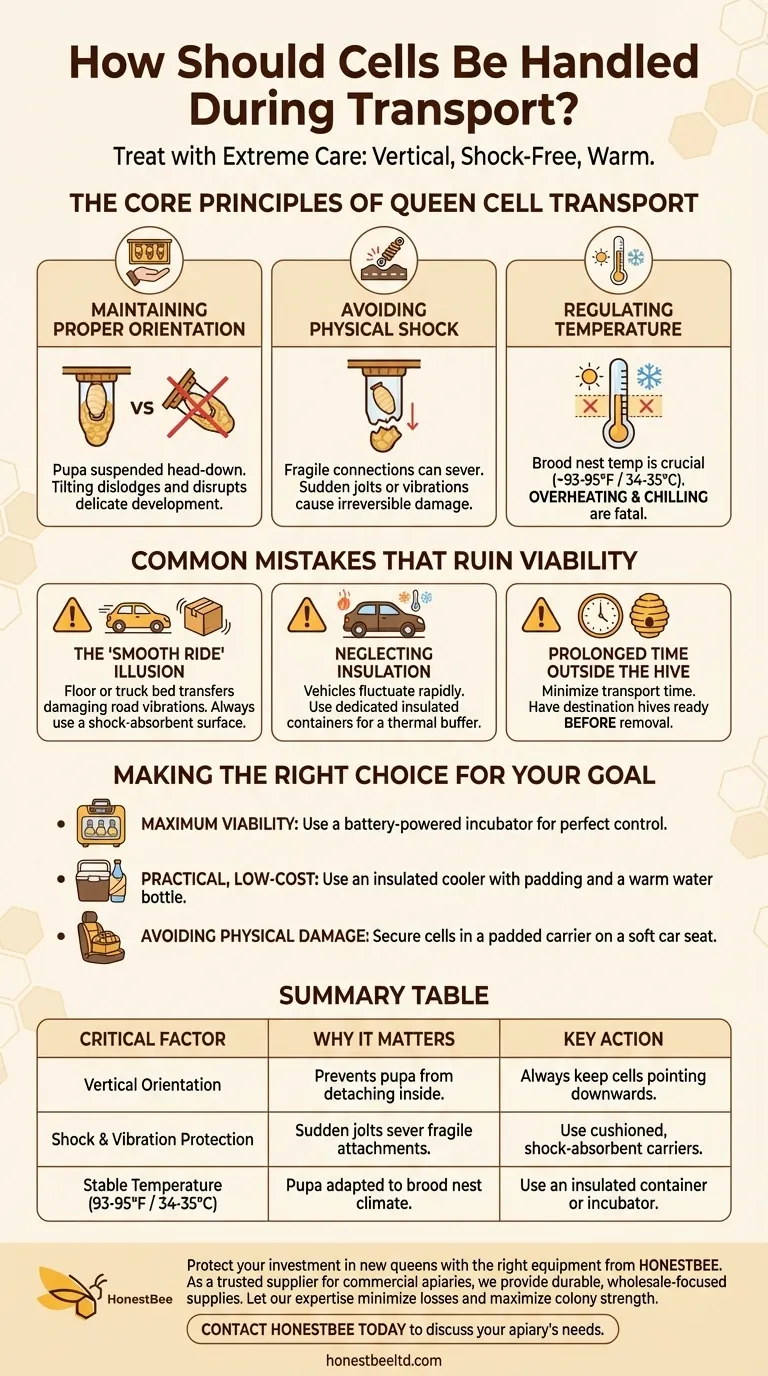
Related Products
- Brown Nicot Queen Cell Cups for Breeding Queen Bees Beekeeping
- JZBZ Type Wide Base Plastic Queen Cell Cups for Base Mounting and Queen Rearing
- 5 Gallon Pail Opener Bucket Opener Tool for Honey Bucket
- Stainless Steel Beekeeping Honey Extractor Lid
- Ergonomic Squeezable Honey Bottle with Precision Twist Nozzle Cap
People Also Ask
- What role does the natural swarming process play in queen rearing? Harness the Swarm Instinct for Better Queens
- How does Queen Rearing with JZBZ work? A Reliable System for Consistent Queen Production
- Why is it important to select a healthy larva less than 24 hours old for queen rearing? Maximize Queen Quality and Colony Strength
- What is the advantage of the Nicot Cupkit system? Secure Your Queen Rearing Success with Batch Protection
- What is the benefit of inducing supersedure by giving a queenright colony a protected queen cell? A Seamless Requeening Method




